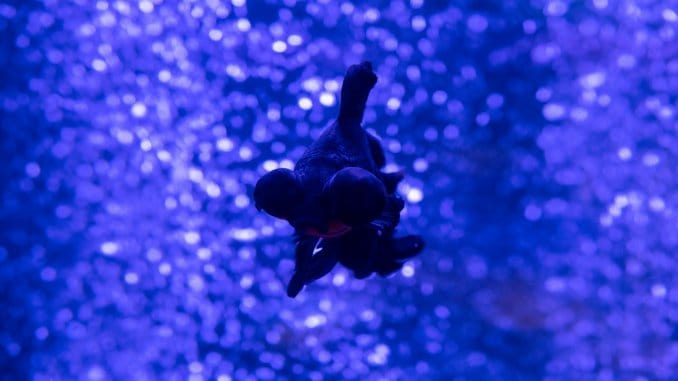
The black moor goldfish is a freshwater species of fancy goldfish and is a black-colored variant of the telescope goldfish.
Most common goldfish are orange, white, or red, but the black moor goldfish’s stunning, black color makes it a popular goldfish among aquarists. These fish are peaceful and low-maintenance, making them ideal pets for beginner fishkeepers.
TABLE OF CONTENTS
Black Moor Goldfish Facts & Overview
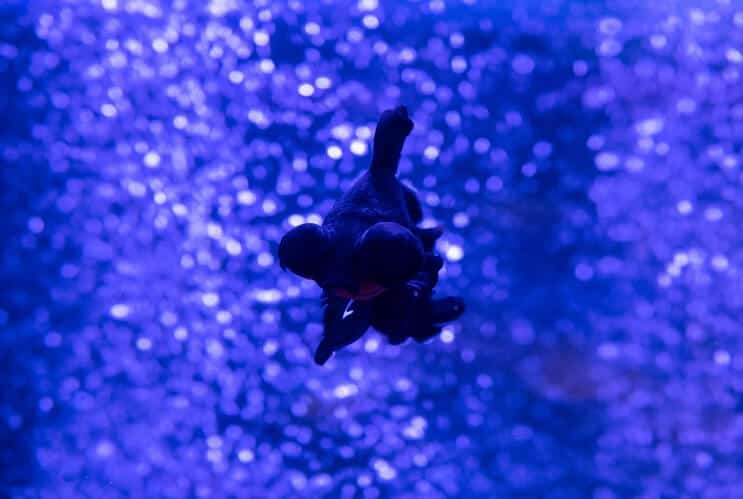
| Scientific name: | Carassius auratus |
| Common names: | Black moor goldfish, black telescope goldfish, dragon eye goldfish, black peony goldfish, black demekin |
| Distribution: | China |
| Size: | 6–8 inches |
| Life expectancy: | 10–15 years |
| Color: | Solid black, sometimes with gold or orange patches |
| Diet: | Omnivore |
| Temperament: | Peaceful |
| Minimum tank size: | 20 gallons |
| Temperature: | 50–75°F (10–24°C) |
| pH: | 6.5–7.5 |
| Hardness: | 5–15 dGH |
| Care level: | Easy |
| Breeding: | Egg layer |
Origin & Distribution
Black moor goldfish are selectively-bred, domesticated goldfish that are thought to have originated in China in the 1400s. The fish was first known as “dragon eyes” or “dragon fish.” Black moors are believed to have been imported to the US in the 1800s.
The black moor goldfish is made by breeding the red telescope and the veiltail or fringetail fancy goldfish.
The natural habitats of these two goldfish species are freshwater lakes, canals, rivers, and reservoirs. These areas have slow-moving waters, a neutral pH, and a sand or dirt substrate. Red telescope and fringetail fancy goldfish are able to withstand a wide variety of temperatures.
Adult Size & Lifespan
The fully-grown, adult black moor goldfish is 6–8 inches long. Males are smaller and slimmer than females.
On average, a black moor goldfish lives for 10–15 years in captivity.
Availability
Black moor goldfish aren’t as widely available as other goldfish species because this fish is a man-made variant and needs to be selectively bred. The easiest way to find black moors is online.
You can buy these goldfish for $6–$10 per fish from the following reputable stores:
Appearance & Behavior
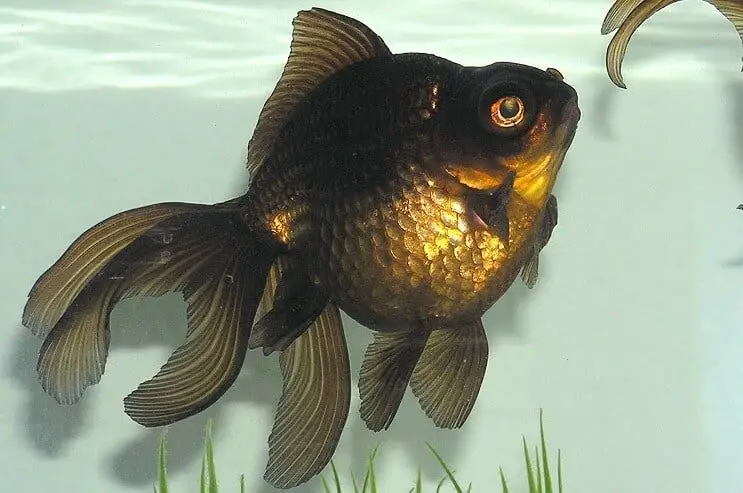
The black moor goldfish is a black fancy goldfish with distinct protruding eyes. The fish is peaceful, timid, and a slow swimmer.
Colors, Patterns, Fins, and Sex Differences
Black moor goldfish have egg-shaped bodies that are all-black bodies or black with orange or silver patches. The fish have long flowing fins and a fan-like tail.
Young black moor goldfish are bronze or gold. As the fish age, their bodies turn black and their eyes protrude. Despite their unusually large eyes, these fish have impaired vision.
Aside from size, there’s no difference in appearance between male and female black moor goldfish, which makes sexing the fish difficult. During spawning season, males develop tiny white bumps, called breeding tubercles, on their pectoral fins.
Black moor goldfish become paler if they are housed in poor water conditions, don’t receive enough light, or develop diseases like velvet.
Typical Behavior
The black moor goldfish is a peaceful, slow-swimming fish that gets along well with other fish and isn’t territorial. This species is active and known to chase and nip the fins of other black moors.
This goldfish prefers to swim in the mid-levels of the tank and hides when startled by loud noises or aggressive tank mates.
During daylight hours, black moor goldfish are most active. The fish eat and explore the tank during the day, and sleep in caves or behind plants overnight.
Black Moor Goldfish Care & Tank Requirements
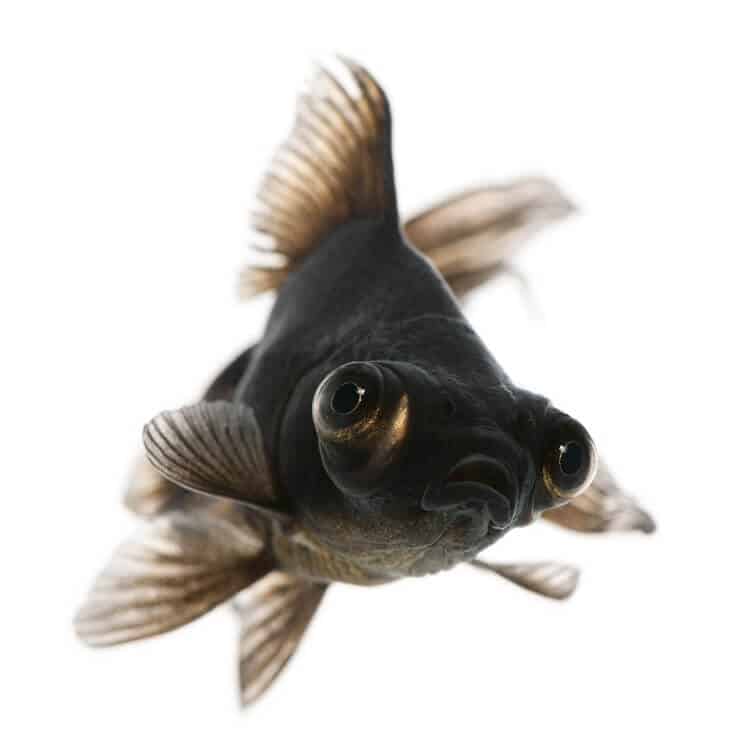
Caring for black moor goldfish is easy. The fish need a clean, freshwater tank environment with consistent parameters and a varied omnivorous diet of plants and proteins.
Habitat and Tank Requirements
Black moor goldfish don’t have a natural habitat because they’re man-made fish.
The natural habitat of the black moor’s parent breed, the telescope goldfish, is stagnant or slow-flowing, murky waters in China. Replicate this environment in the black moor’s home aquarium with proper water conditions and suitable decorations.
Line the base of the tank with a layer of sand or gravel. Black moor goldfish don’t spend much time at the bottom of the aquarium, so tailor the substrate towards bottom-dwelling tank mates.
Provide hiding spots in the tank with caves, rocks, and plants like Java ferns and hornwort. Rocks and bogwort have a natural appeal, but themed decorations like miniature castles and shipwrecks can also be used.
The minimum tank size for a black moor goldfish is 20 gallons. The fish have long fins, that take up a lot of space, and they need enough room to swim around. For every extra goldfish, provide an additional 10 gallons of tank space.
Tank Conditions
Ideal tank conditions for black moor goldfish are:
| Water type: | Neutral, slow-moving freshwater |
| Tank size: | Minimum 20 gallons and an extra 10 gallons per additional black moor goldfish |
| Water temperature: | 50–75°F |
| Substrate: | Fine gravel or sand |
| Tank setup: | Rocks, caves, plants |
| Acidity: | 6.5–7.5 pH |
| Water hardness: | 5–15 dGH |
| Filter: | Yes, to provide a slow current and keep the water clean |
| Bubbler: | Not necessary as long as you have a good filter |
| Lighting: | Standard aquarium lighting on a timer |
| Water heater: | Not necessary because the fish enjoy room-temperature water |
Black moor goldfish are hardy fish that don’t need fancy equipment to stay healthy. As long as the tank contains a high-quality filter, the fish should thrive.
Disease
There are several diseases and health problems that black moor goldfish are prone to in captivity:
Swim Bladder Disease
Swim bladder disease affects a fish’s ability to control its buoyancy. A fish with swim bladder disease floats tail-up or nose-down, sinks to the bottom, or floats to the top of the water.
The best swim bladder disease remedy is to feed the fish a single green pea, followed by no food for 48 hours. Surgery may be required for severe cases.
Eye Damage
The black moor goldfish’s eyes are delicate and more likely to become damaged because the eyes protrude from the head.
To prevent damage to the black moor’s eyes, keep the fish in a tank with smooth objects and transfer the fish between tanks gently using a net.
Tank Mates
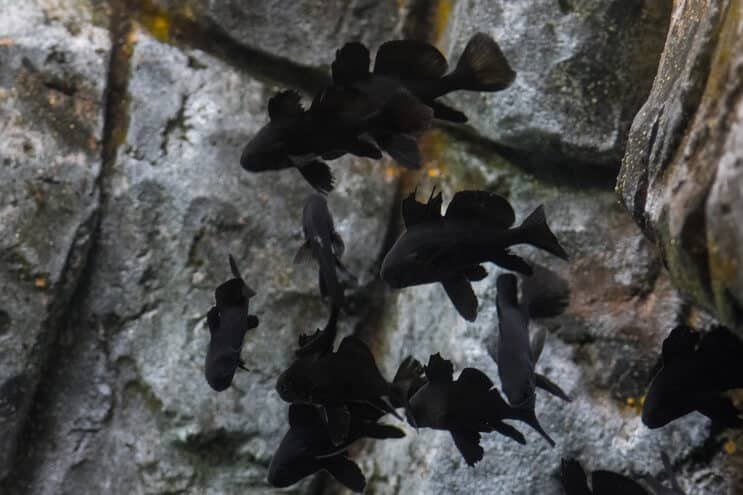
Black moor goldfish should be housed with peaceful fish that won’t harass or bully them. Good tank mates for black moors include other fancy goldfish, small groups of shoaling fish, and large, slow-swimming fish.
Other suitable tank mates for black moor goldfish are:
- Other black moors (buy the fish in groups of at least two for companionship)
- Oranda goldfish
- Mollies
- Zebra danios
- Neon tetras
- Barbs
- Dwarf gouramis
- Catfish
- Kuhli loaches
- Bristlenose plecos
Avoid housing black moor goldfish with fin-nipping tank mates like tiger barbs, betta fish, and angelfish.
Keeping Black Moor Goldfish Together
Because this variety of Goldfish is so docile, you can keep them in groups without them displaying signs of aggression.
Diet and Feeding
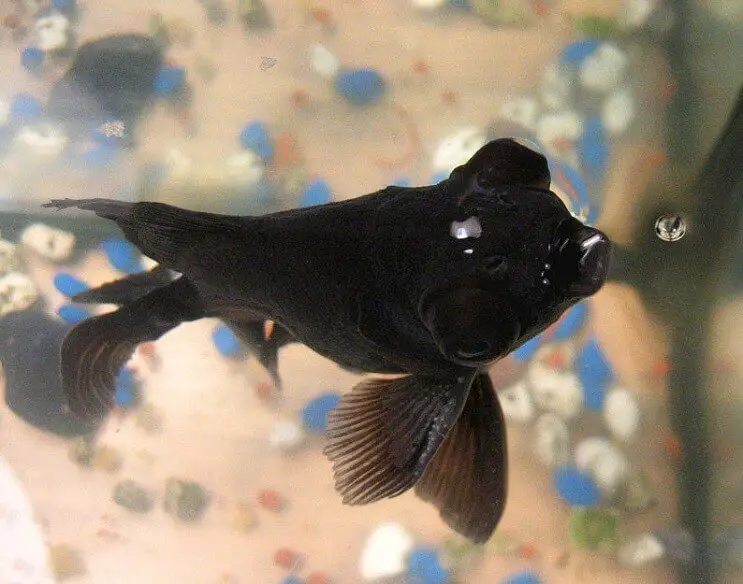
In the wild, the black moor goldfish’s breed-parent, the telescope goldfish, eats insects, vegetable matter, small crustaceans, and detritus. Feed black moor goldfish a similar, varied diet in captivity.
The bulk of the fish’s diet should be dried flakes or pellets. These foods are cheap to buy in bulk and provide a range of nutrients. Feed your fish live or frozen foods like brine shrimp, daphnia, and bloodworms, several times a week.
Green vegetables like blanched spinach, lettuce, and broccoli support the fish’s digestive system and should be provided at least once a week.
Feed your fish twice a day, providing enough food that can be eaten in two minutes. Don’t overfeed these fish because they’re prone to obesity and related health conditions like bloat and swim bladder disease.
Breeding
Breeding black moor goldfish at home is easy, even for people with no prior fish breeding experience. The fish reach sexual maturity at about one year old.
To successfully breed a pair of black moor goldfish, follow these steps:
- Set up a separate breeding tank with identical water conditions and decorations to the home tank.
- Add a healthy male and female fish to the breeding tank. To mimic the seasonal changes that trigger spawning in the wild, slowly increase the temperature by 3 degrees per day until the temperature is 75°F.
- If the male is interested in breeding, he will court the female by swimming around her in circles for several days.
- An interested female will develop and release eggs on flat surfaces around the tank. Females can lay up to 10,000 eggs at once.
- The male will brush over the eggs and fertilize them with his milt — a reproductive fluid containing sperm.
- Once the male has finished fertilizing the eggs and moved away from the area, remove both the parents and return them to the home tank to prevent them from eating the eggs.
- Remove the unfertilized eggs from the tank with a small scoop or net to avoid polluting the water. Healthy, fertilized eggs are clear-colored, while unfertilized eggs develop fungus and turn white.
- The eggs will hatch three to five days after they’re fertilized. Feed the fry small iron- and protein-rich foods, like baby brine shrimp, until the fry are about two months old.
- When they’re two months old, the fry can be moved to separate tanks and fed an adult fish’s diet.
Should You Get a Black Moor Goldfish for Your Aquarium?
Black moor goldfish are unique, peaceful fish that are good pets for beginners and experts alike.
You should get a black moor goldfish if you have a suitably-sized freshwater tank that houses peaceful, slow-moving fish. Don’t get a black moor goldfish if your tank contains territorial fish, aggressive fish, or fish that are known to nip this goldfish’s long, flowing fins.
As long as you keep the black moor’s water conditions clean and don’t overfeed this goldfish, it should be a stunning, entertaining addition to your tank that will thrive for at least 10 years.



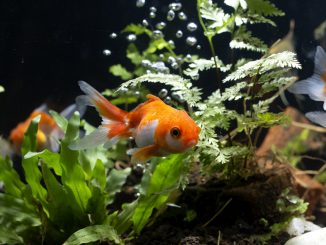
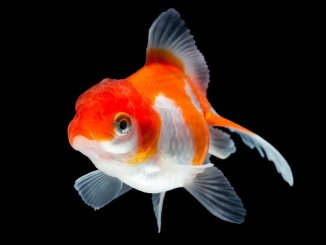
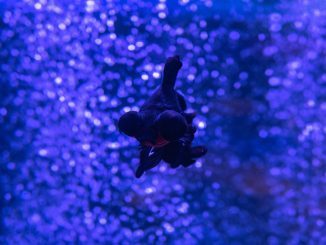
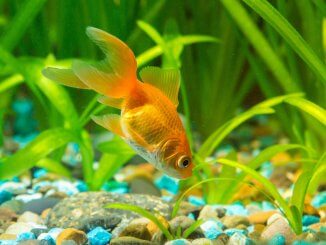
i have bee keeping end breeding fish for 40 years but i still like seeing this column come into my inbox and enjoy reading it. often i learn something new so keep up the good work!!
Barbs are able to nimble on a long fins of many goldfish varieties, so I would not recommend this combination of fish
Neon tetras need doing great in acidic water, while a goldfish really flourishing in alkaline water. Not a god combination.
Goldfish will most likely finish most if not all live plants in a tank.
Goldfish does not need hiding places, especially telescopes due to their limited vision ability. I have and bred goldfish (and other aquarium fish) most of my life (about 50 years)
One of my black moors has started constantly returning to a certain spot in the tank and just hovering in that spot. It’s almost like he is laying on the gravel. What is this a sign of? Should I be worried about him?
It says 20 gallons. Does that mean 20 gallons per Blackmoor fish?
nope! 20 for the first, then 10 gallons per fish for the rest
Dan black Moores be kept with calicos?
Its been awhile since you posted this comment, but the answer is yes. they can cohabit.
I have had my moor for about seven years and really enjoy him. I clean his tank and he rearranges it how he wants it! I put my hand in the tank and he rubs all over it.he likes when his belly is gently rubbed. He is the best! Him and my cat are good friends. I put him in a large bowl when i clean the tank and put the bowl on the floor and him and the cat watch each other for a while. My cat will go to sleep next to the bowl. Good fish!
Do my black moors need cycling (an air stone, etc) or is the filter enough movement? I’m using the Fluval 306 filter in a 40 gallon breeder tank. The problem is that the filter is at the far end, back of the aquarium so a lot of debris stays at the end away from the filter. It has to remain here because of the stand it is sitting on. I have some stone the size of quarters, more or less, on most, but not all, of the bottom.
Also what brand and size heater(watts) do you recommend to maintain an even temperature. It gets a bit chilly in our upstairs in winter and I want to be sure temperature is not an issue.
I appreciate you help,
Thanks,
Kathy
for your tank i recommend a 200 watt heater and keep it to 60-70 degrees as they like colder temps
I am new to fish keeping
My husband bought me my tank and black 2 moor fish yesterday, and now am doing as much research as I can, I’m very excited.
I have 3 blackmoor goldfish in my 60gal tank and I awsome filter and it has air pumped through it. I know they are surface breathers but they do like to swim and play in the bubbles it’s quite amazing to watch them.
What do you recommend I try for my black moor that is sick. He’s just over 2 1/2 yrs old. The tank he has been in has gotten green algae or mold growth rather quickly lately. He is moved out of there with stress coat & water safe added, but appears very sick. He is at the bottom of the temporary water home he is in & doesn’t appear to have eaten for several days. Not sure what else to try. (Wish I could post a pic)
Prime, Stressguard and kanaplex in baths for 15 minutes daily. do not dose kanaplex in a tank. you can put pellets in the leftover bath water and feed it to the goldfish to allow the medication to enter the body and help that way too.
Can you have 2 black moors in a 20 gallon tank
Great infro thank you
I’ve had my Blackmore for around two years now and have it in a tank with a golden oranda, can someone please tell me how to tell the sex of my fish.
Hi! Thank you for all these informations.. I’ve got 3 Moors recently, and they are around 5cm big. I wonder how fast do they grow up? And is it ok (safe) to add one big Moor or Golden to the aquarium (which is really huge)? Thanks in advance!
I hope I’m doing this right. I’ve had my black moor, Slurpee, for almost four years now. Recently I’ve noticed on his, not sure just calling it a him, pectoral fins bumpy growths that look kind of white on the top but not fuzzy or furry. Neither do they have any open ulcers. He’s not having any problems swimming and isn’t bumping or rubbing against things in the tank he shares with a pleco. Anyone have any ideas on what this might be? Also, he has very long, flowy beautiful tail fins and I’ve yet to see any photos of other moors with fins like his.
It could potentially be ick, and there’s different treatments for it in most pet stores. I used tablets before when I did a sudden tank change due to the previous tank breaking. . Ick can be caused by stress from tank mates, sudden temperature change (especially after water change), or poor living condition
We have a black moor in a 20 gallon tank. He is 2.5 years old and up until this week was sharing with our Oranda (bought the two together in the pet shop not realising that the tank would be too small for them both). All good until about two months ago when he started harassing our female Oranda to the point where we had to take her out. Unfortunately she didn’t make it. He’s on his own in the tank now and for the first day or two he was whizzing around like a crazy thing (missing his tank mate??).
I’m wondering whether to leave him in there on his own or not. I would like to put a couple of tank mates in there but don’t want to have an overcrowded tank either.
have 2 black mores and a regular fantail had 2 babies and was able to help only one survive the baby is now about 11/2 inches not black are orange more of a golden color has fan tail and regular eyes.